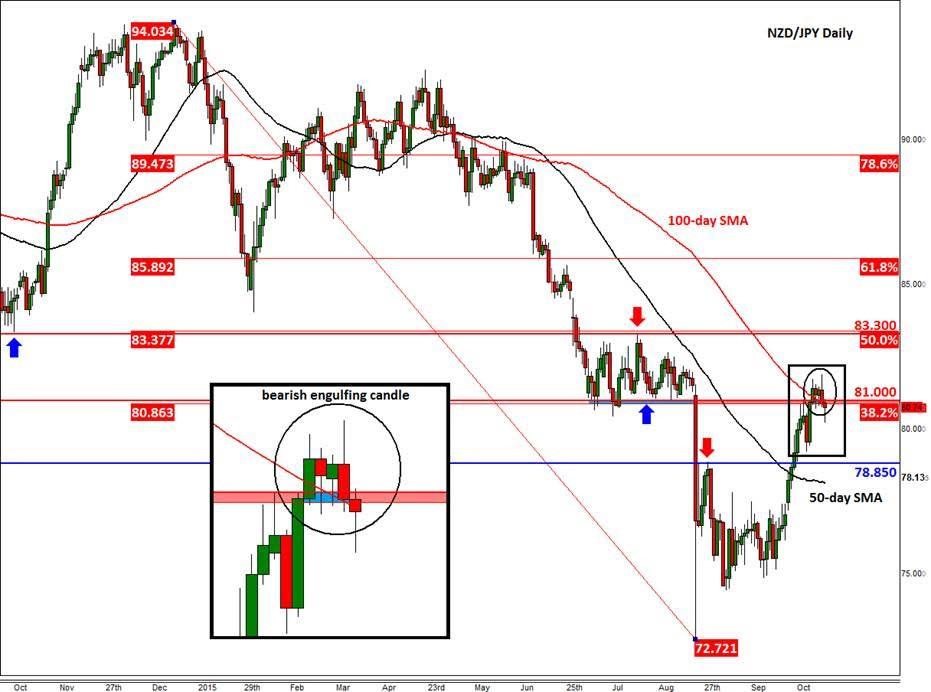![]()
The NZD/JPY may not be the most talked-about currency pair, but following an unexpected fall in dairy prices at the Fonterra GlobalDairyTrade auction yesterday, the kiwi’s recent good run of form may have ended. Dairy prices at the auction dropped 3.1% and ended a run of four consecutive increases, while the price of powdered whole milk, New Zealand's major export, dropped 4.6%. However, it is not all doom and gloom for New Zealand. The fall in dairy prices could just be a hiccup, while interest rates in New Zealand are among the highest in developed economies due in part to the housing market boom in Auckland. Indeed, if risk sentiment improves then the NZD could start to outperform, especially against currencies where the central bank is dovish, such as the yen and euro. So at this stage it is not very clear which direction the NZD/JPY is headed, but depending on the direction of its next move, we could see some significant follow-through in that direction.
As a result of the drop in the GDT index, the kiwi has weakened across the board, with the NZD/USD dropping below the key 0.6800 technical level and AUD/NZD forming a large bullish engulfing candle on its daily chart, though the latter is held back by an underperforming AUD and also the 200-day moving average which is offering some resistance. The NZD/JPY is probably one of the more interesting kiwi crosses to watch for the USD/JPY has retreated back to the pivotal 120.00 handle where it may find some resistance in the near term.
The yen weakened overnight following the release of some disappointing trade figures from Japan which showed the slowest pace of growth for exports in more than a year in September, as a drop in shipments to Asia, most notably China, offset gains in sales to Europe and the US. Imports meanwhile dropped 11%. Going forward, if the weakness persists for Japanese data then this would raise the pressure on the Bank of Japan to increase its stimulus measures, particularly if we see negative growth for the third quarter which would put the economy in a technical recession. This could weigh heavily on the yen and lift the Nikkei index.
Nevertheless, the yen could come back in the short term, especially as it is starting to look a little bit overbought against the USD. Indeed, given the technical importance of the 120 handle, we wouldn’t be surprised if the USD/JPY turns back lower from around here, which could help to accelerate the NZD/JPY’s potential drop.
On the other hand, if the USD/JPY continues to push higher now and the NZD also stabilises then the NZD/JPY could potentially move sharply higher as the sellers abandon their positions. So, there could be decent trading opportunities on either side for the NZD/JPY, depending on the direction of the break.
Yesterday, the NZD/JPY formed a bearish-engulfing-like candle on its daily chart which has seen the cross move back below the technically-important level of 81.00 (previous support-turned-resistance and 100-day moving average). So, for as long as price now remains below here then the path of least resistance would be to the downside. But a close back above this level and a potential break above the high of yesterday’s candle, around 81.90, would invalidate this short-term bearish outlook, possibly leading to some sharp gains.
Thus, bullish traders may wish to wait until the NZD/JPY clears 81.90 before showing their presence, while the bears will be happy for as long as 81.00 caps the upside.
On the downside, the next potential support is the psychologically-important 80.00 handle, followed by the previous resistance at 78.85 and then the 50-day SMA around 78.15. On the upside, the next major resistance is at 83.30/40, an area which was formerly support and resistance and corresponds with the 50% retracement level of the downswing from the significant high of around 94.00, hit in December of last year, to August’s low of 72.70.
Trading leveraged products such as FX, CFDs and Spread Bets carry a high level of risk which means you could lose your capital and is therefore not suitable for all investors. All of this website’s contents and information provided by Fawad Razaqzada elsewhere, such as on telegram and other social channels, including news, opinions, market analyses, trade ideas, trade signals or other information are solely provided as general market commentary and do not constitute a recommendation or investment advice. Please ensure you fully understand the risks involved by reading our disclaimer, terms and policies.
Recommended Content
Editors’ Picks
EUR/USD regains traction, recovers above 1.0700

EUR/USD regained its traction and turned positive on the day above 1.0700 in the American session. The US Dollar struggles to preserve its strength after the data from the US showed that the economy grew at a softer pace than expected in Q1.
GBP/USD returns to 1.2500 area in volatile session

GBP/USD reversed its direction and recovered to 1.2500 after falling to the 1.2450 area earlier in the day. Although markets remain risk-averse, the US Dollar struggles to find demand following the disappointing GDP data.
Gold holds around $2,330 after dismal US data

Gold fell below $2,320 in the early American session as US yields shot higher after the data showed a significant increase in the US GDP price deflator in Q1. With safe-haven flows dominating the markets, however, XAU/USD reversed its direction and rose above $2,340.
XRP extends its decline, crypto experts comment on Ripple stablecoin and benefits for XRP Ledger

Ripple extends decline to $0.52 on Thursday, wipes out weekly gains. Crypto expert asks Ripple CTO how the stablecoin will benefit the XRP Ledger and native token XRP.
After the US close, it’s the Tokyo CPI

After the US close, it’s the Tokyo CPI, a reliable indicator of the national number and then the BoJ policy announcement. Tokyo CPI ex food and energy in Japan was a rise to 2.90% in March from 2.50%.
